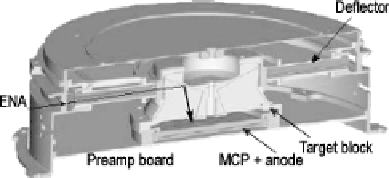Geoscience Reference
In-Depth Information
Fig. 1.
Illustration of the NPI geometry.
oxygen
8
has previously been done. Here we investigate the ENA fluxes in
Mars' umbra. One motivation is to search for interplanetary ENA pop-
ulations. The interstellar neutral stream of helium, as detected by the
ULYSSES/GAS-instrument,
9
is of too low energy (13 eV) to be detected
by the NPI, since the NPI only is sensitive to neutrals with an energy of at
least 200 eV (see Fig. 11) and the energy of the interstellar neutral helium
will be below this energy even if we account for Mars' orbital velocity, and
the gravitational acceleration of Mars and the Sun.
However, many different observations hint at the existence of other inter-
planetary fluxes of neutral atoms (no direct observations have been made),
as described by Collier
et al.
10
Such streams might have energies in the keV
range, detectable by the NPI. The most promising part of Mars Express'
orbit to search for such streams is in the shadow of the planet since we then
do not have any direct solar UV light contamination, and the flux of ENAs
from the Mars-solar wind interaction should be low.
In Fig. 2 we see an example of the raw data from an eclipse observation.
Mars Express' orbit goes into the shadow at different time periods
(eclipse seasons). The data analyzed here is from two different eclipse sea-
sons, one in 2004 and one in early 2005. This is summarized in Table 1.
Figure 3 shows the eclipse part of the orbit, and how it evolves during these
two eclipse seasons.
To avoid the ENA fluxes at entry and exit of eclipses (probably ENAs
produced by solar wind-exosphere charge exchange that then are scattered
by elastic collisions in the exosphere) we restrict the examined data to obser-
vations when the spacecraft is at least 0.15 Martian radii inside the umbra
(if not otherwise noted). We call these observations deep umbra observa-
tions. The value of 0.15 was chosen after examining how the count rates
depend on distance inside the umbra for all the observations. It was found
that the countrates level off inside this region, as illustrated in Fig. 2(b).
Examples of NPI's FOV in ecliptic coordinates are shown in Fig. 4 with
Mars' limb and center also indicated. During Earth communication the









